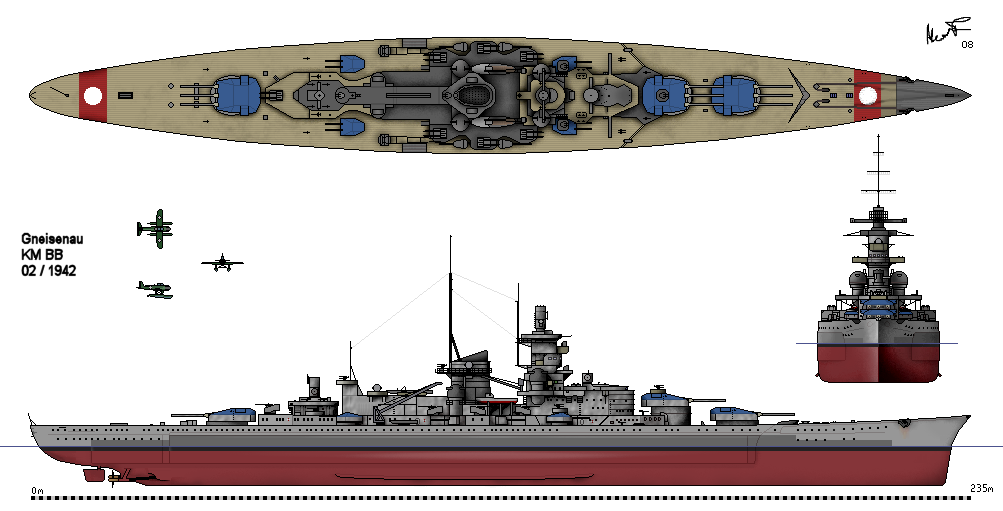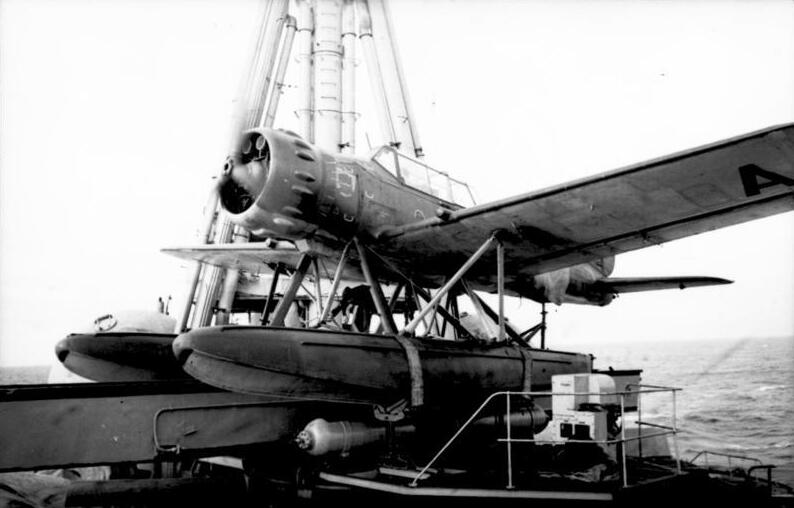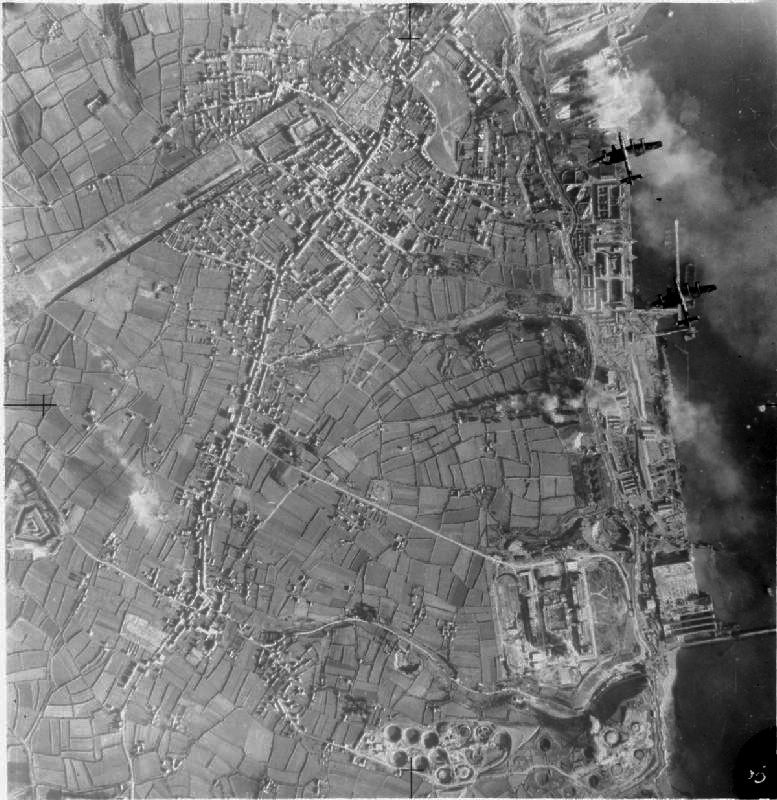|
Scharnhorst-class Battleship
The ''Scharnhorst'' class was a class of German battleships (or battlecruisers) built immediately prior to World War II. The first capital ships of Nazi Germany's ''Kriegsmarine'', it comprised two vessels: and . ''Scharnhorst'' was launched first, and is considered to be the lead ship by some sources; they are also referred to as the ''Gneisenau'' class in some other sources, as ''Gneisenau'' was the first to be laid down and commissioned. They marked the beginning of German naval rearmament after the Treaty of Versailles. The ships were armed with nine 28 cm (11 in) SK C/34 guns in three triple turrets; plans to replace these with six 38 cm (15 in) SK C/34 guns in twin turrets were never realized. The two ships were laid down in 1935, launched in late 1936, and commissioned into the German fleet by early 1939. ''Scharnhorst'' and ''Gneisenau'' operated together for the early years of World War II, including sorties into the Atlantic to raid British mer ... [...More Info...] [...Related Items...] OR: [Wikipedia] [Google] [Baidu] |
Deutsche Werke
Deutsche Werke was a German shipbuilding company that was founded in 1925 when Kaiserliche Werft Kiel and other shipyards were merged. It came as a result of the Treaty of Versailles after World War I that forced the German defense industry to shrink. The company was owned by the government of the Weimar Republic and its headquarters was in Berlin while the manufacturing location was in Kiel. Deutsche Werke started building merchant ships, but when the Nazi Party gained power in 1933 the production was changed to naval ships. Besides shipbuilding, Deutsche Werke also produced firearms. Especially well-known are the so-called Ortgies pistols, which were particularly popular in the United States. The pistols were developed by Heinrich Ortgies. During World War II the company expanded to Gdynia, establishing ''Deutsche Werke Gotenhafen''. Deutsche Werke facilities and infrastructure were destroyed during World War II by bombing raids. Parts of the works were reorganised as Maschi ... [...More Info...] [...Related Items...] OR: [Wikipedia] [Google] [Baidu] |
Arado Ar 196
The Arado Ar 196 was a shipboard reconnaissance low-wing monoplane aircraft built by the German firm of Arado starting in 1936. The next year it was selected as the winner of a design contest and became the standard aircraft of the ''Kriegsmarine'' (German Navy) throughout World War II. Design and development In 1933, the ''Kriegsmarine'' looked for a standardized shipboard observation floatplane. After a brief selection period, the ''Reichsluftfahrtministerium'' (German Air Ministry, RLM) decided on the Heinkel He 60 biplane. This was one of a line of developments of a basic biplane airframe that appeared as a number of floatplanes, trainers, and fighters. Deliveries started in a matter of months. By 1935, it was found that the He 60's performance was lacking and the RLM asked Heinkel to design its replacement. The result was the He 114. The first prototype was powered by the Daimler-Benz DB 600 inline engine, but it was clear that supplies of this engine would be limited ... [...More Info...] [...Related Items...] OR: [Wikipedia] [Google] [Baidu] |
English Channel
The English Channel, "The Sleeve"; nrf, la Maunche, "The Sleeve" (Cotentinais) or ( Jèrriais), (Guernésiais), "The Channel"; br, Mor Breizh, "Sea of Brittany"; cy, Môr Udd, "Lord's Sea"; kw, Mor Bretannek, "British Sea"; nl, Het Kanaal, "The Channel"; german: Ärmelkanal, "Sleeve Channel" ( French: ''la Manche;'' also called the British Channel or simply the Channel) is an arm of the Atlantic Ocean that separates Southern England from northern France. It links to the southern part of the North Sea by the Strait of Dover at its northeastern end. It is the busiest shipping area in the world. It is about long and varies in width from at its widest to at its narrowest in the Strait of Dover."English Channel". ''The Columbia Encyclopedia'', 2004. It is the smallest of the shallow seas around the continental shelf of Europe, covering an area of some . The Channel was a key factor in Britain becoming a naval superpower and has been utilised by Britain as a natural def ... [...More Info...] [...Related Items...] OR: [Wikipedia] [Google] [Baidu] |
Channel Dash
The Channel Dash (german: Unternehmen Zerberus, Operation Cerberus) was a German naval operation during the Second World War. (Cerberus), a three-headed dog of Greek mythology who guards the gate to Hades. A (German Navy) squadron comprising the two s, the heavy cruiser and their escorts was evacuated from Brest in Brittany to German ports. ''Scharnhorst'' and ''Gneisenau'' had arrived in Brest on 22 March 1941 after the success of Operation Berlin in the Atlantic. More raids were planned and the ships were refitted at Brest. The ships were a threat to Allied trans-Atlantic convoys and RAF Bomber Command attacked them from 30 March 1941. ''Gneisenau'' was hit on 6 April 1941 and ''Scharnhorst'' on 24 July 1941, after dispersal to La Pallice. In late 1941, Adolf Hitler ordered the (OKM; German Navy High Command) to plan an operation to return the ships to German bases against a British invasion of Norway. The short route up the English Channel was preferred to a detour around ... [...More Info...] [...Related Items...] OR: [Wikipedia] [Google] [Baidu] |
Operation Weserübung
Operation Weserübung (german: Unternehmen Weserübung , , 9 April – 10 June 1940) was Germany's assault on Denmark and Norway during the Second World War and the opening operation of the Norwegian Campaign. In the early morning of 9 April 1940 (''Wesertag'', "Weser Day"), Germany occupied Denmark and invaded Norway, ostensibly as a preventive manoeuvre against a planned, and openly discussed, French-British occupation of Norway known as Plan R 4 (actually developed as a response to any German aggression against Norway). After the occupation of Denmark (the Danish military was ordered to stand down as Denmark did not declare war with Germany), envoys of the Germans informed the governments of Denmark and Norway that the ''Wehrmacht'' had come to protect the countries' neutrality against Franco-British aggression. Significant differences in geography, location and climate between the two nations made the actual military operations very dissimilar. The invasion fleet's no ... [...More Info...] [...Related Items...] OR: [Wikipedia] [Google] [Baidu] |
38 Cm SK C/34 Naval Gun
The 38 cm SK C/34SK – ''Schnelladekanone'' (quick loading cannon); ''C – Construktionsjahr'' (year of design) naval gun was developed by Germany mid to late 1930s. It armed the s and was planned as the armament of the s and the re-armed s. Six twin-gun mountings were also sold to the Soviet Union and it was planned to use them on the s, however they were never delivered. Spare guns were used as coastal artillery in Denmark, Norway and France. One gun and one barrel is currently on display at respectively Møvig Fortress outside Kristiansand and Bunkermuseum Hanstholm, Denmark. Ammunition It used the standard German naval system of ammunition where the base charge was held in a metallic cartridge case and supplemented by another charge in a silk bag. Both cartridges were rammed together. ;Propellant charge Main charge: 38 cm HuelsKart34 – GefLdG – RP C/38 (16/7) Fore charge: 38 cm VorKart34 – GefLdG – RP C/38 (16/7) Shell Four types of shells were us ... [...More Info...] [...Related Items...] OR: [Wikipedia] [Google] [Baidu] |
Treaty Of Versailles
The Treaty of Versailles (french: Traité de Versailles; german: Versailler Vertrag, ) was the most important of the peace treaties of World War I. It ended the state of war between Germany and the Allied Powers. It was signed on 28 June 1919 in the Palace of Versailles, exactly five years after the assassination of Archduke Franz Ferdinand, which led to the war. The other Central Powers on the German side signed separate treaties. Although the armistice of 11 November 1918 ended the actual fighting, it took six months of Allied negotiations at the Paris Peace Conference to conclude the peace treaty. The treaty was registered by the Secretariat of the League of Nations on 21 October 1919. Of the many provisions in the treaty, one of the most important and controversial was: "The Allied and Associated Governments affirm and Germany accepts the responsibility of Germany and her allies for causing all the loss and damage to which the Allied and Associated Governments and the ... [...More Info...] [...Related Items...] OR: [Wikipedia] [Google] [Baidu] |
Lead Ship
The lead ship, name ship, or class leader is the first of a series or class of ships all constructed according to the same general design. The term is applicable to naval ships and large civilian vessels. Large ships are very complex and may take as many as five to ten years to build. Improvements based on experience with building and operating the lead ship are likely to be incorporated into the design or construction of later ships in the class, so it is rare to have vessels that are identical. The second and later ships are often started before the first one is completed, launched and tested. Nevertheless, building copies is still more efficient and cost-effective than building prototypes, and the lead ship will usually be followed by copies with some improvements rather than radically different versions. The improvements will sometimes be retrofitted to the lead ship. Occasionally, the lead ship will be launched and commissioned for shakedown testing before following ship ... [...More Info...] [...Related Items...] OR: [Wikipedia] [Google] [Baidu] |
Kriegsmarine
The (, ) was the navy of Germany from 1935 to 1945. It superseded the Imperial German Navy of the German Empire (1871–1918) and the inter-war (1919–1935) of the Weimar Republic. The was one of three official branches, along with the and the , of the , the German armed forces from 1935 to 1945. In violation of the Treaty of Versailles, the grew rapidly during German naval rearmament in the 1930s. The 1919 treaty had limited the size of the German navy and prohibited the building of submarines. ships were deployed to the waters around Spain during the Spanish Civil War (1936–1939) under the guise of enforcing non-intervention, but in reality supported the Nationalists against the Spanish Republicans. In January 1939, Plan Z, a massive shipbuilding program, was ordered, calling for surface naval parity with the British Royal Navy by 1944. When World War II broke out in September 1939, Plan Z was shelved in favour of a crash building program for submarines (U-boat ... [...More Info...] [...Related Items...] OR: [Wikipedia] [Google] [Baidu] |
Nazi Germany
Nazi Germany (lit. "National Socialist State"), ' (lit. "Nazi State") for short; also ' (lit. "National Socialist Germany") (officially known as the German Reich from 1933 until 1943, and the Greater German Reich from 1943 to 1945) was the German state between 1933 and 1945, when Adolf Hitler and the Nazi Party controlled the country, transforming it into a dictatorship. Under Hitler's rule, Germany quickly became a totalitarian state where nearly all aspects of life were controlled by the government. The Third Reich, meaning "Third Realm" or "Third Empire", alluded to the Nazi claim that Nazi Germany was the successor to the earlier Holy Roman Empire (800–1806) and German Empire (1871–1918). The Third Reich, which Hitler and the Nazis referred to as the Thousand-Year Reich, ended in May 1945 after just 12 years when the Allies defeated Germany, ending World War II in Europe. On 30 January 1933, Hitler was appointed chancellor of Germany, the head of gove ... [...More Info...] [...Related Items...] OR: [Wikipedia] [Google] [Baidu] |
World War II
World War II or the Second World War, often abbreviated as WWII or WW2, was a world war that lasted from 1939 to 1945. It involved the vast majority of the world's countries—including all of the great powers—forming two opposing military alliances: the Allies and the Axis powers. World War II was a total war that directly involved more than 100 million personnel from more than 30 countries. The major participants in the war threw their entire economic, industrial, and scientific capabilities behind the war effort, blurring the distinction between civilian and military resources. Aircraft played a major role in the conflict, enabling the strategic bombing of population centres and deploying the only two nuclear weapons ever used in war. World War II was by far the deadliest conflict in human history; it resulted in 70 to 85 million fatalities, mostly among civilians. Tens of millions died due to genocides (including the Holocaust), starvation, ma ... [...More Info...] [...Related Items...] OR: [Wikipedia] [Google] [Baidu] |
Battlecruiser
The battlecruiser (also written as battle cruiser or battle-cruiser) was a type of capital ship of the first half of the 20th century. These were similar in displacement, armament and cost to battleships, but differed in form and balance of attributes. Battlecruisers typically had thinner armour (to a varying degree) and a somewhat lighter main gun battery than contemporary battleships, installed on a longer hull with much higher engine power in order to attain greater speeds. The first battlecruisers were designed in the United Kingdom, as a development of the armoured cruiser, at the same time as the dreadnought succeeded the pre-dreadnought battleship. The goal of the design was to outrun any ship with similar armament, and chase down any ship with lesser armament; they were intended to hunt down slower, older armoured cruisers and destroy them with heavy gunfire while avoiding combat with the more powerful but slower battleships. However, as more and more battlecruisers were ... [...More Info...] [...Related Items...] OR: [Wikipedia] [Google] [Baidu] |








_-_March_17%2C_1924.jpg)